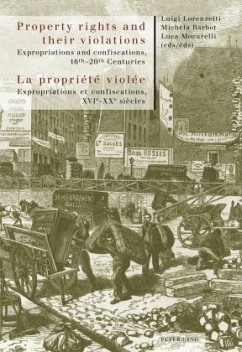Interest in the history of ownership rights is growing and spreading to different disciplines. Historians are turning their attention mainly to the rise of private and individual ownership as it was codified in 19 th -century liberal Europe. In writing this history, however, their perspective has too often ignored the other side of the coin, namely the restrictions which the sovereign imposed on such rights, allegedly in the interest of the community.
The papers collected in the present volume suggest that private property is not necessarily the most safeguarded legal model, hence it is not less vulnerable to violation. They construct a close analysis of the most common forms of abuse of private property on record - expropriation, seizure, and confiscation - perpetrated by public authorities. They also seek to define the uneasy, often intricate relation between legal and legitimate . In a perspective of lights and shadows, the role of confiscation and expropriation changes : now seen as powerful instruments of change, now as enduring factors of conservation in the evolution of private ownership rights.
Les droits de propriété sont depuis longtemps au coeur de l'intérêt de diverses disciplines. L'attention des historiens s'est focalisée surtout sur la naissance de la propriété privée et individuelle telle qu'elle a été codifiée dans l'Europe libérale du XIX e siècle. Toutefois, son histoire a trop souvent négligé l'autre face de la médaille, à savoir les limites fixées à ce droit par le souverain au nom de l'intérêt de la collectivité. Les contributions figurant dans ce volume suggèrent que la propriété privée individuelle ne représente pas le modèle juridique le plus apte à la protéger face aux risques d'infraction. Au coeur des analyses il y a les formes historiques de la violation de la propriété privée - expropriations, saisies, confiscations - perpétrées par les autorités et le rapport, souvent complexe et ambigüe, entre les dimensions de la légalité et de la légitimité. Dans un jeu d'ombres et de lumières, les confiscations et les expropriations se dessinent à la fois comme de puissants instruments de changement et de tenaces facteur de conservation dans l'évolution des formes de propriété.
The papers collected in the present volume suggest that private property is not necessarily the most safeguarded legal model, hence it is not less vulnerable to violation. They construct a close analysis of the most common forms of abuse of private property on record - expropriation, seizure, and confiscation - perpetrated by public authorities. They also seek to define the uneasy, often intricate relation between legal and legitimate . In a perspective of lights and shadows, the role of confiscation and expropriation changes : now seen as powerful instruments of change, now as enduring factors of conservation in the evolution of private ownership rights.
Les droits de propriété sont depuis longtemps au coeur de l'intérêt de diverses disciplines. L'attention des historiens s'est focalisée surtout sur la naissance de la propriété privée et individuelle telle qu'elle a été codifiée dans l'Europe libérale du XIX e siècle. Toutefois, son histoire a trop souvent négligé l'autre face de la médaille, à savoir les limites fixées à ce droit par le souverain au nom de l'intérêt de la collectivité. Les contributions figurant dans ce volume suggèrent que la propriété privée individuelle ne représente pas le modèle juridique le plus apte à la protéger face aux risques d'infraction. Au coeur des analyses il y a les formes historiques de la violation de la propriété privée - expropriations, saisies, confiscations - perpétrées par les autorités et le rapport, souvent complexe et ambigüe, entre les dimensions de la légalité et de la légitimité. Dans un jeu d'ombres et de lumières, les confiscations et les expropriations se dessinent à la fois comme de puissants instruments de changement et de tenaces facteur de conservation dans l'évolution des formes de propriété.








